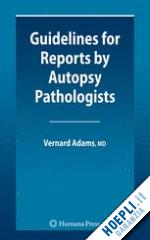
Questo prodotto usufruisce delle SPEDIZIONI GRATIS
selezionando l'opzione Corriere Veloce in fase di ordine.
Pagabile anche con Carta della cultura giovani e del merito, 18App Bonus Cultura e Carta del Docente
Preface *
List of Appendices *
List of Figures. *
Acknowledgments *
Table of Contents *
Part I. Autopsy Protocol *
Purpose, Structure, and Organization *
Purpose *
Structure *
Organization. *
Measurements *
Diagnostic Terms *
External Examination *
Inventory of Parts *
Clothing and Surface Evidence *
Identifying Features *
Signs of Death *
Organization of External Findings *
Therapy *
Organ and Tissue Donation *
Wounds by Type *
General Organization *
Outside-in *
Paragraphs *
Impact Wounds *
Blade Wounds *
Hanging *
Firearm Wounds *
Burns and Fire Deaths *
Wounds by Organ *
Measurements *
Bones: General *
Skull and Dura *
Ribs *
Long Bones and Pelvis *
Vertebrae *
Ligaments, Joints and Muscle *
Body Cavities *
Great Vessels *
Heart *
Central Nervous System *
Lungs *
Liver *
Spleen *
Internal Examination *
Autopsy Procedures *
Wounds, Therapy, and Donations *
Body Cavities *
Heart and Great Vessels *
Lungs *
Liver, Bile Ducts, Gallbladder and Pancreas *
Reticuloendothelial System *
Genitourinary System *
Endocrine Organs *
Digestive Organs *
Musculoskeletal System *
Neck *
Head *
Tumors *
Part II. Opinion Reports *
The Logic of Opinion Formation *
Definitions of Cause, Mechanism, and Manner *
Global Approach *
Synthesis of Cause, Mechanism, and Manner *
Competing Diseases and Injuries *
Degree of Certainty *
Diagnoses in Tabular Format *
Purpose *
Structure *
Diagnosis or Finding? *
What to Include *
Cause of Death as Diagnosis *
Completeness and Etiologic Specificity *
Diagnoses in Narrative Format: The Summary and Opinion Report *
Purpose *
Structure *
History *
Autopsy Findings *
Opinions *
Part III. Other Reports *
Ancillary Laboratory Reports *
Integration and Signature *
Fixed Organs *
Microscopic Descriptions *
Scene Investigation by Pathologist *
Purpose *
Structure *
Case identification *
Background Information. *
Environment *
Body *
Actions Taken *
Animal Bones *
Purpose *
Structure *
Content *
Part IV. Style *
Construction *
Sentences *
Paragraphs *
Abbreviations *
Parentheses *
Adjectives *
Verbs *
Natural Indexing *
Dictating to Avoid Editing *
Attorneys’ Rules of Construction *
Inserting Minor Opinions *
Word Order *
Terminology *
Anatomical Terminology *
Latin and Greek *
Slang *
Brand Names *
General Terminology *
Part V. Death Certification *
Purpose and History *
Death certificate forms. *
Establishing that death occurred *
Cause of death *
Codeable Causes of Death *
Format for Cause of Death Opinion *
Degree of Certainty *
Approximate Interval: Onset to Death *
Manner of death *
Purpose *
Manner of Death Problems *
Life Insurance Issues Related to Manner of Death *
Circumstances *
How Injury Occurred *
Location of Injury *
Place of Injury *
Part VI. Record Retention *
Purpose *
Types of Records *
Autopsy Reports *
Case File Notes *
Death Certificates *
Deposition Transcripts *
Police Reports *
Hospital Patient Records *
Autopsy Recordings *
Investigations of Bodies to be Cremated *
No-jurisdiction Case Notes *
Business Records *
Physical Evidence *











Il sito utilizza cookie ed altri strumenti di tracciamento che raccolgono informazioni dal dispositivo dell’utente. Oltre ai cookie tecnici ed analitici aggregati, strettamente necessari per il funzionamento di questo sito web, previo consenso dell’utente possono essere installati cookie di profilazione e marketing e cookie dei social media. Cliccando su “Accetto tutti i cookie” saranno attivate tutte le categorie di cookie. Per accettare solo deterninate categorie di cookie, cliccare invece su “Impostazioni cookie”. Chiudendo il banner o continuando a navigare saranno installati solo cookie tecnici. Per maggiori dettagli, consultare la Cookie Policy.